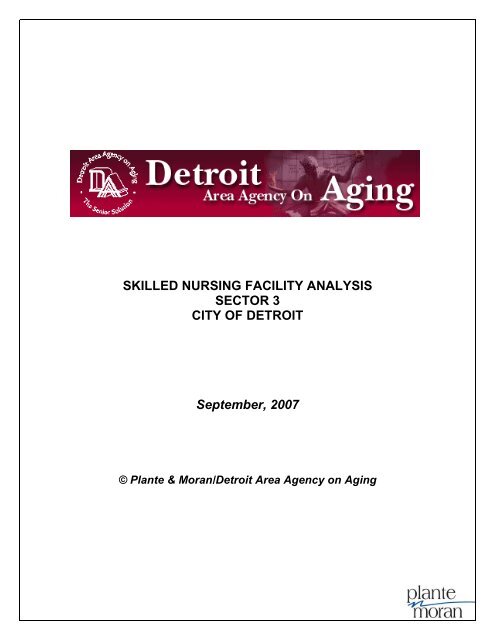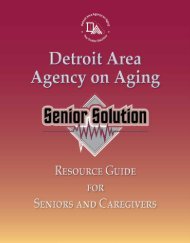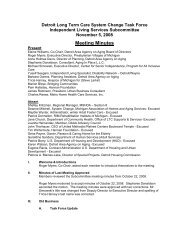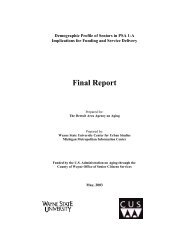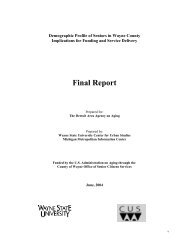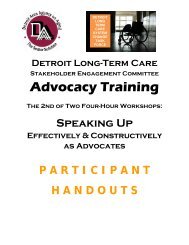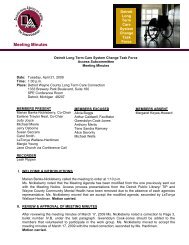DAAA Skilled Nursing Facility Analysis Executive Summary
DAAA Skilled Nursing Facility Analysis Executive Summary
DAAA Skilled Nursing Facility Analysis Executive Summary
Create successful ePaper yourself
Turn your PDF publications into a flip-book with our unique Google optimized e-Paper software.
SKILLED NURSING FACILITY ANALYSIS<br />
SECTOR 3<br />
CITY OF DETROIT<br />
September, 2007<br />
© Plante & Moran/Detroit Area Agency on Aging
Background<br />
The Detroit Area Agency on Aging (<strong>DAAA</strong>)<br />
has been in the process of assisting and<br />
analyzing the care needs of the elderly in the<br />
City of Detroit. By initiating the Dying Before<br />
Their Time Task Force, the <strong>DAAA</strong> has<br />
brought attention to the significant care needs<br />
of seniors in the city and the lack of services<br />
to meet those needs.<br />
A major concern facing <strong>DAAA</strong> is the number<br />
of long-term care beds that have been lost<br />
recently, due to the closure of nursing homes<br />
in the City of Detroit. An additional number of<br />
skilled nursing facilities (SNFs) are currently<br />
experiencing financial and operational<br />
difficulties and might close, taking additional<br />
beds out of service. As a result, this project<br />
was undertaken in order to identify facilities<br />
vulnerable to closure and strategies to<br />
improve the overall quality of care in Detroit<br />
skilled nursing facilities.<br />
The initial phase of the study included an<br />
extensive analysis of the facilities located in<br />
Sector 3 (Eastern region) of the City of<br />
Detroit. Onsite facility visits were conducted<br />
and both regulatory and financial and<br />
operating statistics were reviewed in detail.<br />
The second phase of the study included a<br />
limited analysis of the remaining Medicaid<br />
certified facilities in the City of Detroit.<br />
Regulatory and financial and operating<br />
statistics were compiled and reviewed from<br />
public data sources. No onsite facility visits<br />
were conducted.<br />
This report includes a synopsis of the findings<br />
and recommendations from both studies.<br />
Project Scope and Objectives<br />
• Assess the facilities located in the City<br />
of Detroit for the purpose of identifying<br />
clinical and financial operating issues<br />
that may affect the facility’s ability to<br />
provide high quality care, barriers to<br />
meeting regulatory requirements and<br />
facilities at risk for closure<br />
• Evaluate how well the demand for<br />
services is being met<br />
• Identify strategies for improvement for<br />
vulnerable and struggling facilities<br />
Project Team<br />
The Project Team included the following<br />
consultants from the Plante & Moran Senior<br />
Care & Living Services Group:<br />
• Jerry Gumbleton, CPA, Partner<br />
• Betsy V. Rust, CPA, Manager<br />
• Brenda Sowash, BSN, RN, Senior<br />
Consultant<br />
• Melanie Nabozny, RN, Senior<br />
Consultant<br />
Methodology and Data Sources<br />
• Most recent facility survey histories<br />
were analyzed<br />
• Quality Indicator reports were<br />
reviewed for the majority of facilities.<br />
• Financial and Operating statistics were<br />
analyzed from 2005 Medicaid Cost<br />
Reports and October 1, 2006 Rate<br />
Sheets<br />
• Resident interviews were conducted in<br />
some instances.<br />
• <strong>Facility</strong> tours were conducted to target<br />
environmental, Life Safety, resident<br />
care and dignity concerns.<br />
• <strong>Facility</strong> chart reviews were completed.<br />
• Key owners and nurse management<br />
personnel were interviewed.<br />
1
City of Detroit<br />
<strong>Skilled</strong> <strong>Nursing</strong> Facilities<br />
A total of 4370 licensed beds in 36 Medicaid<br />
certified facilities are available in the <strong>DAAA</strong>’s<br />
service area, including Highland Park, Harper<br />
Woods and the Grosse Pointes. There is one<br />
facility that is not certified for Medicaid.<br />
• There is significant ownership of beds<br />
by four entities (56%)<br />
• The predominance of ownership is by<br />
proprietary organizations. There are<br />
only five not-for-profit facilities.<br />
• There are significant clusters of<br />
facilities (Sector 3 serving the city’s<br />
east side and Sector 9 serving the<br />
northwest). There are some sectors<br />
with little to no bed capacity.<br />
Detroit Area Agency on Aging Service<br />
Area<br />
2 5<br />
2<br />
3<br />
1<br />
3<br />
3 1<br />
# = Number of <strong>Skilled</strong> <strong>Nursing</strong> Facilities<br />
NORTHERN REGION = 10 SNF’s<br />
• Sectors 1, 2, 10, 11, 12<br />
0<br />
(1276 beds)<br />
SOUTHERN REGION = 5 SNF’s<br />
• Sectors 4, 5, 6 (629 beds)<br />
EASTERN REGION = 13 SNF’s<br />
• Sector 3 (1218 beds)<br />
<strong>Summary</strong> of Significant Findings<br />
2<br />
1<br />
3<br />
Michigan. These groups include adult,<br />
non-elderly residents, HIV dependent<br />
and homeless individuals, and<br />
persons with chronic mental health,<br />
substance abuse and behavior issues.<br />
We also noted a very high incidence of<br />
residents with wounds and infections<br />
as compared to other facilities.<br />
• Medicaid utilization in Detroit is higher<br />
than Michigan averages.<br />
• Medicare utilization in Detroit is less<br />
than Wayne County and Michigan<br />
averages. There is a strong correlation<br />
between higher Medicare utilization<br />
and favorable financial results. Many<br />
of the facilities indicated difficulty in<br />
accessing Medicare residents through<br />
the hospital discharge process.<br />
• Occupancy in Detroit is less than<br />
Michigan averages. Occupancy is<br />
lowest in the Eastern Regions where<br />
there appears to be excess capacity.<br />
• A significant number of patients are<br />
sent to the hospital when they could<br />
be cared for at the nursing home due<br />
to the lack of adequately trained staff.<br />
As a result, both Medicaid and<br />
Medicare incur higher costs to care for<br />
these patients.<br />
• Medicare Special Needs Plans<br />
(Fidelis) have enrolled many Detroit<br />
Medicaid residents in their Part A<br />
Advantage Plans. They provide onsite<br />
case management and caregiver<br />
assistance for their enrollees. As a<br />
result, this may improve the overall<br />
quality of care in Detroit facilities and<br />
will likely reduce the rate of<br />
readmission to hospitals.<br />
<strong>Facility</strong> Occupancy<br />
92.00%<br />
90.00%<br />
88.00%<br />
86.00%<br />
84.00%<br />
Patient Profiles and <strong>Facility</strong> Capacity<br />
• The Detroit SNFs have a significant<br />
population of patients atypical to the<br />
average long term care facility in<br />
82.00%<br />
80.00%<br />
Western<br />
Region<br />
Michigan<br />
Average<br />
Southern<br />
Region<br />
Northern<br />
Region<br />
Wayne<br />
County<br />
Average<br />
Eastern<br />
Region<br />
2
<strong>Facility</strong> Payor Mix<br />
100%<br />
Detroit <strong>Skilled</strong> <strong>Nursing</strong> Facilities<br />
Average Number of Health Citations<br />
16<br />
90%<br />
80%<br />
70%<br />
60%<br />
50%<br />
40%<br />
30%<br />
Other<br />
Medicare<br />
Medicaid<br />
13<br />
10<br />
20%<br />
10%<br />
7<br />
0%<br />
Wayne<br />
County<br />
Average<br />
Eastern<br />
Region<br />
Western<br />
Region<br />
Northern<br />
Region<br />
Southern<br />
Region<br />
Michigan<br />
Average<br />
Clinical Services – Regulatory<br />
Compliance<br />
• Detroit SNFs have a higher level of<br />
health and life safety citations than<br />
Michigan and National averages.<br />
• A contributing factor to the high<br />
number of life safety citations is the<br />
significant age of the physical plant.<br />
• During the site visits of many of the<br />
facilities, we noted a higher degree of<br />
concern/harm than what was cited<br />
during the latest survey. Several<br />
jeopardy situations were found during<br />
the site visits.<br />
• All facilities had observed concerns in<br />
incident and accident prevention and<br />
monitoring<br />
• There was a high correlation between<br />
the “hands on” involvement of the<br />
management group and the efficiency<br />
and effectiveness of the facility.<br />
• There was a wide disparity in the<br />
expertise and capability of the <strong>Nursing</strong><br />
Administration Staff. We noted more<br />
employee turnover in the management<br />
positions than in the staff positions<br />
which leads to decreased clinical<br />
outcomes and poor system<br />
implementation<br />
• Overall, the facilities did not appear<br />
significantly understaffed. Many of the<br />
facilities reported staffing at higher<br />
levels than the average Michigan<br />
facility.<br />
• Existing staff need additional training<br />
and education to increase their<br />
effectiveness and improve patient<br />
outcomes.<br />
3<br />
4<br />
National<br />
Average<br />
Michigan<br />
Average<br />
Northern<br />
Region<br />
Eastern<br />
Region<br />
Southern<br />
Region<br />
Detroit <strong>Skilled</strong> <strong>Nursing</strong> Facilities<br />
Average Number of Life Safety Citations<br />
12<br />
10<br />
8<br />
6<br />
4<br />
2<br />
-<br />
National<br />
Average<br />
Michigan<br />
Average<br />
Northern<br />
Region<br />
Eastern<br />
Region<br />
Southern<br />
Region<br />
Western<br />
Region<br />
Western<br />
Region<br />
Medicaid Reimbursement<br />
• The majority of Detroit SNFs are<br />
reimbursed under the Medicaid limit<br />
for operating expenses.<br />
• A significant number of facilities<br />
experienced un-reimbursed but<br />
allowable costs due to low occupancy<br />
as Medicaid imputes an 85%<br />
occupancy level to facilities in<br />
determining allowable cost.<br />
• Medicaid has further limitations on<br />
specific classifications of cost (referred<br />
to as support) and some providers<br />
experienced un-reimbursed cost due<br />
to this issue.<br />
• For the Medicaid rate year beginning<br />
October 1, 2006 through September<br />
30, 2007, the total un-reimbursed but<br />
allowable cost due to these issues<br />
was approximately $2,000,000.
• Bed escrows or de-licensure of beds<br />
would mitigate this issue and has been<br />
utilized by a few providers. However,<br />
some facilities are hesitant to reduce<br />
bed capacity based on the belief that<br />
some providers will soon close,<br />
providing future opportunities for<br />
improved census at their buildings.<br />
• The provider tax program contributes<br />
positively to financial results for most<br />
facilities<br />
2005 Operating Expenses Per Patient Day<br />
$158.00<br />
$155.00<br />
$152.00<br />
$149.00<br />
$146.00<br />
$143.00<br />
October 1, 2006 Medicaid Rates –<br />
Exclusive of the Provider Tax Program<br />
$140.00<br />
Eastern<br />
Region<br />
Southern<br />
Region<br />
Northern<br />
Region<br />
Western<br />
Region<br />
Michigan<br />
Average<br />
$155.00<br />
$150.00<br />
$145.00<br />
$140.00<br />
$135.00<br />
$130.00<br />
$125.00<br />
$120.00<br />
$115.00<br />
Variable Costs VCL Medicaid Rate Effective 10/1/06<br />
Western Region Southern Region Northern Region Eastern Region<br />
The Medicaid rate is the sum of the variable<br />
(operating) and capital costs.<br />
<strong>Facility</strong> Operations<br />
• Operating expenses per patient day<br />
were less than statewide averages<br />
(computed at 85% occupancy).with<br />
the greatest differential in the nursing<br />
services area.<br />
• Significant variations between Detroit<br />
facilities were noted in nursing,<br />
dietary, and plant operation and<br />
maintenance services.<br />
• Employee benefits and workers<br />
compensations costs as a percentage<br />
of wages were less than statewide<br />
averages for most facilities.<br />
Capital Reimbursement Issues and<br />
Opportunity for Investment<br />
• There is a correlation between<br />
capital reimbursement and length<br />
of ownership. The majority of<br />
facilities have been owned for<br />
more than 12 years, which is<br />
favorable for reimbursement.<br />
• There has been minimal<br />
reinvestment in the majority of<br />
facilities, and most are under the<br />
capital asset value limitations for<br />
reimbursement.<br />
• Many of the facilities have little<br />
outstanding debt.<br />
• Many of the facilities would be<br />
eligible for additional<br />
reimbursement for capital<br />
expenditures.<br />
• There are certain unfavorable<br />
limitations in the Medicaid<br />
regulations related to<br />
replacements of existing assets<br />
and total facility replacements that<br />
deter owners from investing.<br />
• Several owners reported difficulty<br />
in accessing capital for renovation<br />
projects due to the unwillingness<br />
of lenders to finance urban nursing<br />
homes.<br />
• Financing rates for Detroit SNFs<br />
are often higher than market rates.<br />
4
550,000<br />
500,000<br />
450,000<br />
Average Capital Expenditures During<br />
Five Year Period from 2000-2005<br />
ventilator dependent, substance and<br />
other abusers, and individuals with<br />
significant wounds and pressure<br />
ulcers. A large number of homeless<br />
individuals were served in the Eastern<br />
Region.<br />
400,000<br />
350,000<br />
300,000<br />
250,000<br />
200,000<br />
150,000<br />
100,000<br />
Northern Region Southern Region Eastern Region Western Region<br />
Financial Management<br />
• There were varying degrees of<br />
reimbursement knowledge among the<br />
owner/administrator group. There was<br />
less knowledge about the complicated<br />
capital reimbursement regulations<br />
• Almost all of the facilities reported a<br />
profit per resident day for the year<br />
ended 12/31/05 (Medicaid rates for<br />
2005 were established based on cost<br />
and census data from 2003).<br />
• Collection of accounts receivable is a<br />
significant problem for many of the<br />
facilities due to delays in establishing<br />
Medicaid eligibility and non collection<br />
of patient pay amounts<br />
• Designated Department of Health<br />
Services (DHS) workers are utilized in<br />
some of the facilities to expedite the<br />
Medicaid eligibility and enrollment<br />
process.<br />
Conclusions<br />
Bed and Service Capacity<br />
• There is excess capacity in the<br />
Eastern Region. The remaining<br />
geographical areas have occupancy<br />
comparable to Michigan averages with<br />
some facilities experiencing<br />
occupancy less than 85%.<br />
• The excess capacity results in unreimbursed<br />
cost for many providers<br />
and resulting cost savings to Medicaid.<br />
• There is a significant demand for<br />
services for at risk groups such as<br />
5<br />
Regulatory Compliance and Clinical<br />
Services<br />
• The majority of facilities have higher<br />
than average health and life safety<br />
citations and remain at risk for<br />
continuing this pattern as many of the<br />
citations are due to a lack of<br />
investment in physical plant or<br />
systemic management issues.<br />
• The facilities have a significant<br />
number of life safety deficiencies<br />
related to building, sprinklers, and<br />
other areas. In addition, many have<br />
variances for other physical plant<br />
issues. Many of the facilities have the<br />
opportunity for additional capital<br />
reimbursement within the limitations of<br />
the current system. However, that<br />
system has significant disincentives<br />
for replacement and renovation that<br />
discourage such investment (full<br />
amount of investment is not always<br />
recognized).<br />
• Overall, staffing levels appeared<br />
reasonable in comparison to industry<br />
averages. Increased education and<br />
reduced turnover in key management<br />
positions would likely improve the<br />
quality of care.<br />
Medicaid Reimbursement and<br />
Operating Issues<br />
• The majority of facilities are<br />
reimbursed at rates less than existing<br />
Medicaid limits for operating expenses<br />
and could be eligible for increased<br />
reimbursement for staff training or<br />
other facility improvements. However,<br />
such increases are dependent upon<br />
Medicare and Medicaid Regulations<br />
on allowable costs, continued funding<br />
of the Medicaid Program at existing<br />
levels and the normal two year lag in<br />
reimbursement rates.
• Staffing levels appeared comparable<br />
to other facilities. However, wage<br />
rates, benefits, and workers<br />
compensation costs were less than<br />
Michigan averages.<br />
• There has been minimal capital<br />
investment in the majority of facilities.<br />
Although there are opportunities to<br />
obtain additional reimbursement for<br />
capital expenditures for most of the<br />
facilities, the existing system has<br />
significant constraints for replacement<br />
assets that serves as a disincentive.<br />
• Cash flow is an issue for many of<br />
these providers. Facilities indicated<br />
significant delays in establishing<br />
Medicaid eligibility for beneficiaries<br />
and in collecting private pay amounts.<br />
In addition, owners also indicated the<br />
inability to access short term working<br />
capital or long term funding due to the<br />
increased credit risk associated with<br />
Detroit facilities.<br />
• The majority of the facilities have the<br />
potential to remain financially viable.<br />
Recommendations for Strategies to<br />
Strengthen Detroit SNFs and<br />
Improve Resident Care<br />
Improvements in the quality of skilled nursing<br />
facilities in the City of Detroit can be<br />
accomplished through the joint efforts of<br />
providers and the Michigan Department of<br />
Community Health. Following are strategies<br />
that would strengthen individual providers and<br />
promote an increase in quality.<br />
Reduce Total Bed Capacity to Reflect<br />
Population and Demand for Services<br />
• Providers - Voluntarily de-license beds<br />
which will also lead to improved<br />
reimbursement rates through<br />
elimination of the 85% occupancy<br />
issue.<br />
• MDCH - Increase enforcement of<br />
survey standards and timely<br />
implementation of plans of correction.<br />
Assist in transition of homeless<br />
resident population that is not nursing<br />
home eligible<br />
Invest in Staff<br />
• Providers - Increase retention of key<br />
management through improved<br />
compensation, leadership training, and<br />
enhancement of the physical<br />
environment through capital<br />
investment. Increase access to higher<br />
skilled workforce through improved<br />
compensation plans.<br />
• MDCH - Facilitate interagency<br />
participation in job training and<br />
recruitment efforts in the City of Detroit<br />
Facilitate Access for Special<br />
Population Groups<br />
• Providers - Ensure adequate training<br />
for staff to appropriately care for<br />
special population groups such as<br />
ventilator dependent, AIDS, substance<br />
abusers and wound care patients.<br />
• MDCH - Provide an incentive for<br />
providers who care for a<br />
disproportionate share of these<br />
residents consistent with appropriate<br />
performance indicators. Assist<br />
providers in identifying resources to<br />
supplement training and education for<br />
special population groups<br />
Invest in Physical Plant<br />
• Providers - Invest in Physical Plant.<br />
Obtain counsel on financial and<br />
reimbursement implications of capital<br />
projects. Continue to seek capital<br />
from both traditional and nontraditional<br />
lending sources. Work with<br />
State associations to encourage<br />
Medicaid to adopt more flexible<br />
reimbursement regulations consistent<br />
with other states<br />
• MDCH - Increase enforcement of<br />
survey standards. Provide education<br />
and assistance to providers in<br />
understanding capital reimbursement<br />
regulations. Provide exceptions to<br />
reimbursement regulations on asset<br />
replacements to encourage<br />
investment. Provide access to capital<br />
for facilities to complete renovation<br />
projects.<br />
6
Improve Care Planning and Delivery<br />
• Providers - Increase facility clinical<br />
expertise to reduce hospital<br />
recidivism. Increase facility expertise<br />
in completion of the MDS and related<br />
care plans. Increase analysis of<br />
Quality Indicator and other clinical<br />
data to identify staff training needs.<br />
• MDCH - Work with Medicare Special<br />
Needs Plans such as Fidelis for case<br />
management assistance of Medicaid<br />
SNF residents. Institute a process to<br />
provide ongoing support to providers<br />
in the implementation of activities that<br />
strengthen care delivery systems<br />
(outside of survey)<br />
Strengthen Financial Position of<br />
Providers to Promote Long Term<br />
Sustainability<br />
• Providers - Voluntarily de-license beds<br />
which will result in improved Medicaid<br />
reimbursement rates. Increase<br />
attention to reimbursement regulations<br />
to take advantage of opportunities to<br />
improve rates. Utilize DHS Outstation<br />
Worker Program where possible to<br />
improve the timeliness of Medicaid<br />
eligibility determinations<br />
• MDCH - Remove 85% occupancy rule<br />
or grant relief to providers in the year<br />
they de-license the beds. Consider<br />
options to increase the flexibility of the<br />
reimbursement system that avoid<br />
linking payment to occupancy<br />
standards or to definitions of cost<br />
classification (i.e. base and support).<br />
Enhance the efficiency and<br />
effectiveness of the Medicaid eligibility<br />
process (e.g. increase the number of<br />
case workers or decrease the<br />
processing time). Investigate<br />
opportunities to assist providers in<br />
minimizing bad debts associated with<br />
patient pay amounts<br />
© Plante & Moran/Detroit Area Agency on Aging<br />
7


